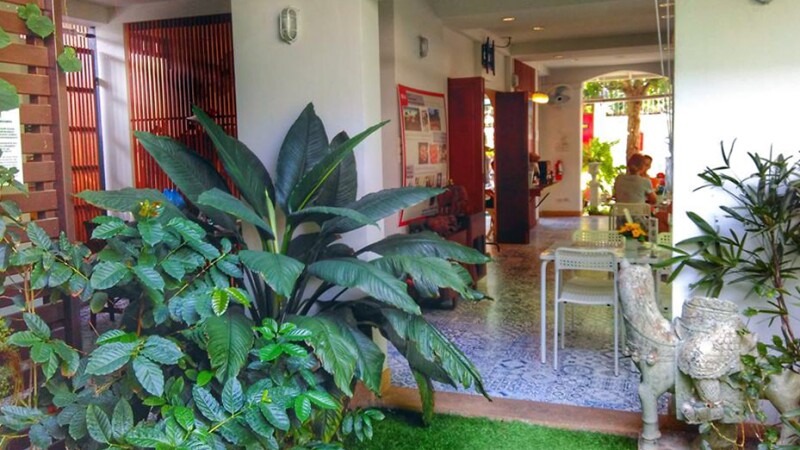Sappayak is a simple snack: minced pork, Thai chilies, and potatoes sprinkled with tamarind and stuffed in a soft Portuguese-style bun. At the Baan Kudichin Museum, it’s served with a glass of Thai-style iced coffee in a lush courtyard decorated with blue azulejos and a statue of the praying Virgin Mary. With the the bells of nearby Catholic Church of Santa Cruz pealing hourly, the Bangkok café feels like its an entire continent away. But sappayak is more than a Thai take on a Portuguese treat; for Navinee Pongthai and the other dozen or so fifth-generation Eurasian families of the Kudichin (or Kudijeen) neighborhood, family recipes like this one, along with the neighborhood’s distinctly European elements, are the last remaining vestiges of 500 years of Portuguese life that predate Bangkok’s founding.
About a year ago, Pongthai converted her aunt’s house into a museum, displaying historic photographs and artifacts. “I thought it was important to educate visitors about our community’s unique history,” she explains. Although Portuguese soldiers first traveled to Thailand in the 1500s as mercenaries in the first Burmese-Siamese war, the Kudichin neighborhood dates back to 1767, when King Taksin set aside the area for the foreign soldiers who helped him win the second Burmese-Siamese war.
The Baan Kudichin museum also houses a café, where Pongthai serves her signature sappayak and a selection of Thai-style desserts. The sappayak is prepared on a tao, an old-school charcoal burner, by Pongthai’s 90-year-old grandmother, or avó, as she affectionately calls her in Portuguese.

The azulejo-covered courtyard of the Baan Kudichin Museum
Courtesy of Baan Kudichin Museum/Facebook
Kudichin’s special history has become important to even its residents who aren’t of Portuguese descent, like Kanita Sakulthong. While Sakulthong isn’t of Portuguese descent, her home-style restaurant, Baan Sakul Thong, showcases a medley of recipes that were handed down from her husband’s third-generation Portuguese grandmother. “She was paralyzed and couldn’t cook anymore, but she wanted to eat the foods she grew up with,” Sakulthong recalls. “She instructed me how to cook these dishes for her. Unfortunately, many other recipes passed away with her that I wish I knew. This restaurant is how I’m able to preserve family history.”
“This restaurant is how I’m able to preserve family history.”
The roots of Sakulthong’s Thai-Portuguese cuisine stretch back to the neighborhood’s early days. “The settlers wanted to have Portuguese food, so their home cooks searched for local ingredients to use for substitutes,” she says. They swapped white sauce for curry paste with coconut milk and served chicken with vermicelli in place of potatoes. One of her specialties is tommafad, a Thai version of cozido, a Portuguese meat-and-vegetable stew. Sakulthong’s version is loaded with spices and served with rice in true Thai fashion, and, she notes, the Portuguese Ambassador to Thailand praised the dish when he first arrived in Bangkok and dined at her restaurant.
“I’m lucky to live here,” Sakulthong says. She explains how a similar community near Holy Rosary Church on the opposite side of the river has had to relocate due to a controversial government-sponsored pedestrian walkway project. Although the Chao Phraya River separates Kudichin from the hullaballoo of Bangkok’s city center, this nevertheless is an ominous portent for Kudichin; its waterside location makes it particularly susceptible to similar threats of development.
Sakulthong asserts, however, that Kudichin is “stronger by comparison” thanks to grassroots guidance from the Urban Design & Development Center (UDDC), an organization committed to reviving historic neighborhoods. Because there isn’t a branch of the Thai government devoted exclusively to urban development, community displacement in the face of urbanization is commonplace.

Khanom farang, or “foreigner cakes,” are one of Kudichin’s best-known treats.
Courtesy of the Tourism Authority of Thailand
That was almost the case with Thanusingha Bakery.
Run by Teepakorn Sudjidjune, the bakery makes one of the neighborhood’s oldest and most popular treats: khanom farang, or “foreigner cakes.” When 16th-century Portuguese settlers first arrived, “They didn’t have access to dairy or yeast,” says Sudjidjune, so his ancestors had to adjust their traditional sponge cake recipe, resulting in the light, crumbly, duck egg–based treats. Sudjidjune uses his great-great grandfather’s original 500-year-old recipe, which effectively introduced bread to Thailand. (The Thai word for bread, pang, comes from the Portuguese word pão.) Today, the treats are so popular, he packages them and distributes them to shops around the city.
When the bakery was in danger of closing due to development, the UDDC spearheaded an open dialogue through public forums and hearings. It appointed community leaders and connected them with activists and with real estate developers, and it worked to emphasize the cultural and culinary significance of the bakery, eventually succeeding in protecting it for at least a while longer.
Not all threats to the neighborhood are external; tensions exist within Kudichin itself, too. When Sakulthong, who is of Thai descent but married into a Portuguese family, was asked to represent Kudichin as a community leader, the proposition was met with opposition by some who view her as an outsider. Additionally, her restaurant has received local recognition and is often featured at food fairs in the city, which some regard as an appropriation of their culture. “I don’t want to steal anything,” Sakulthong says. “I only want to promote the community.” Ultimately, she declined the position as community leader.
Friction like this could be a liability in the future, especially as community activism has proved so important in the neighborhood’s survival. But despite both internal and external stresses, the residents of Kudichin are optimistic about the future. Sakulthong dreams that one day she’ll have a kiosk in front of her house to sell baked goods. Likewise, Pongthai hopes to expand her museum and add translations in additional languages to better share this unique culture with Bangkok residents and visitors from around the world.
“This community has a rich history,” says Sakulthong, “and we work hard to preserve the culture.”











